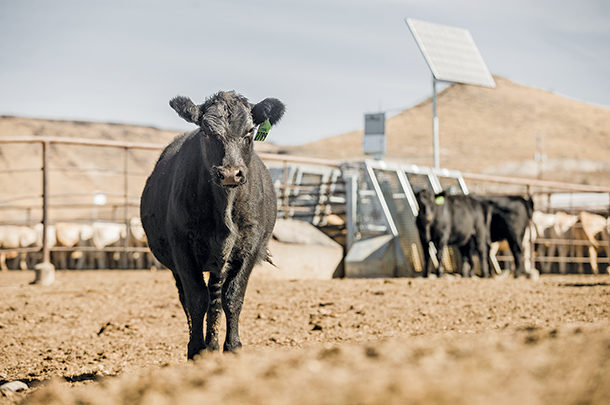No longer do you have to memorize phone numbers, count calories or even check out a blind spot, because technology can do that for us. These items come at a price we are willing to pay to make our daily lives easier. Why not do the same on your cattle operation? Technology should not be looked at as an extra expense anymore. While it does require investment up-front, the long-term savings will come with increased efficiency and decreased labor if utilized effectively.
Technology can be applied in all segments of the beef life cycle. From conception to harvest, each segment has opportunities to utilize technology and potentially increase profitability on the operation.
Here are some examples:
Calving season – Barn cameras and calving book technology
As operations and cow herds grow, labor continues to be a limiting factor, especially during calving season. New wireless cameras and activity monitors are available to help operators check cows from the tractor, house or meeting room. In addition, cameras can decrease time between checks and response time when a calving assistance is needed. As many operations have multiple calving locations, calving book apps and cloud-based programs allow anyone to update calving records without needing to share one book or risk losing valuable information. Ultimately, calving data is now easier to manage and utilize when planning pasture turnout or breeding dates.
Pasture – Drones and virtual fencing
Most cattlemen are eager to turn out to pasture in the spring, but the preparation of repairing fences and checking water access is a labor-intensive job that must be completed first. Now fences can be checked with a drone, saving time driving fences when weather or terrain is not ideal. In addition, fences may soon be a thing of the past with the use of GPS fencing to keep cattle confined in a virtual boundary.
Breeding season – Artificial insemination (A.I.), embryo transfer (ET) and in vitro fertilization (IVF)
Do you want more calves out of a certain sire or dam? While A.I. and ET have become commonplace in the industry, producers can expedite genetic progress with IVF. Replicating genetics faster to increase the calf crop of a desired mating can now be done in one generation versus waiting several years with natural service. Application of hormone-free IVF technology can drive genetic programs with the use of an easy, no- set-up-required system that allows embryos to be made while donors are pregnant.
In most spring-calving herds, cows are bred on pasture. Therefore, heat detection and synchronization programs need to be accessible in remote areas. The use of activity monitor eartags and electronic mounting systems can help keep track of cows that show heat. Studies show cows in estrus prior to insemination are more likely to conceive than cows not in estrus prior to breeding. Estrus detection is a key driver to a successful A.I. or ET program.
Weaning – Automatic syringes and activity monitors
Weaning is one of the most stressful events in a calf’s life and an annual stressor on cows. Setting up calves with preconditioning shots and low-stress weaning are ways that a positive outcome can be seen in future feedlot performance. Making sure cattle get the correct dosage in the right place is also critical to weaning success. Take advantage of automatic vaccine and pour-on guns that will deliver accurate dosage to all animals. Follow BQA guidelines for administration location and change needles often to avoid muscle damage.
Activity monitor systems can help with health monitoring and individual animal performance at weaning as well. Cattle not coming up to the bunk to eat or water tank to drink are showing subclinical signs of sickness. Activity monitors and EID tags can pick up on the lack of activity, which will improve timeliness of health intervention on newly weaned calves.
Post-weaning, the use of individual monitoring systems paired with EID tags can track cattle behavior and identify feed-efficient genetics. Operations can collect data and strive to replicate top phenotypes of average daily gain, dry matter intake (DMI) and residual feed intake to accelerate efficiency and profitability only available with state-of-the-art feeding systems.
Feedlot – Individual animal management
Individual animal management is available to provide increased efficiency to both animals and the operators who use them in feedlot systems. Weigh days are no longer necessary to capture bodyweights and project carcass dressing percentage, as in-pen weights can be collected up to 450 times a day with partial bodyweight technology. Feedlots can now use technology to manage variation and market more uniform loads of cattle. Use of these systems will repay the operation in marketing and labor savings while driving efficiency across the entire operation.
Select a piece of technology that can benefit the operation in several enterprises at different times of the year. For example, calving barn cameras can be utilized in the feedlot throughout the summer to watch cattle behavior, assist with heat detection or even monitor water tanks. ET can be utilized in spring- and fall-bred cow herds, while IVF can be done on pregnant donors up to 100 days of gestation. Feed efficiency can be utilized to test performance of the entire herd on seedstock operations. Testing sale bulls, replacement heifers or even offspring of feed-efficient bulls, all can be tested to collect data and drive accuracy of feed-efficient traits.
Technology is here to stay. Find the piece of technology that will help your operation be more efficient with time, labor and expenses on the operation. It should not be difficult to incorporate technology on your operation if it fits with your goals.








